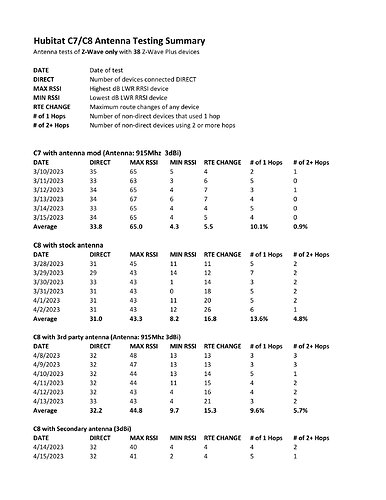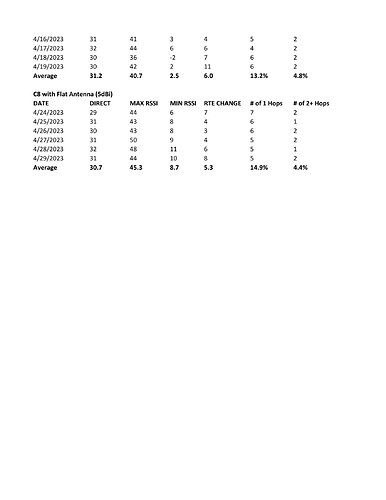I’ve been running tests on a C7 (with antenna mod) and a C8 using various antennas including the stock C8 antenna.
The setup is 38 Z-Wave Plus devices (Zigbee is disabled and antenna removed). During the tests, I did not move/include/exclude any device or performed any firmware updates or move the hub. When the antennas were changed a full shutdown was performed. The mesh was allowed to settle for several days before recording daily values. Data for 6 days was logged for each antenna configuration. The Z-Wave Mesh Tool was used to obtain all values.
Four hardware configurations were tested:
- C7 with antenna mod and 3 dBi antenna
- C8 with stock antenna
- C8 with 2 different 3dBi antennas
- C8 with 5 dBi antenna
Data logged in the tests were:
DIRECT: The daily number of devices connected DIRECT to the hub out of 38 devices.
LWR RSSI: The Last Working Route / Received Signal Strength Indicator in dB. The higher the number the greater the signal strength. Both the MIN and MAX values were recorded. An observation is that the MIN and MAX readings were not necessarily the same devices during the 6 day test.
RTE CHANGE: The maximum number of Route Changes for any device. While this parameter is controlled by the mesh algorithm, it also appears to be dependent upon signal strength.
Number of 1 HOPS: The number of non-DIRECT devices out of 38 using 1 hop (i.e., 0x0A->0x2B).
Number of 2+ HOPS: The number of non-DIRECT devices out of 38 using more than 1 hop (i.e., 0x0A->0x5b->0x2B).
Test #1: C7 with 3dBi Antenna
The results were very impressive. An average of 33.8 devices out of 38 connected DIRECT. Likewise, the MAX RSSI averaged a whopping 65.0 dB compared to 48.0 dB for the C8 using the same 3dBi antenna. The decibel uses a logarithmic base 10 scale, so the C7 signal strength is around 90 times stronger than the C8. This is hard to believe. My guess is the C8 has some type of hardware attenuation, an impedance mismatch, or the RSSI values are reported incorrectly.
Test #2: C8 with Stock Antenna
The average over the 6 day test period was 31 out of 38 devices connected DIRECT. Route changes were all in the teens averaging 16.8, Compared to the C7 which averaged 5.5. It appears there were 3 times more activity is finding new routes using the C8.
Test #3: C8 with 3rd party Antenna(s)
There was some improvement using a 3dBi antenna over the stock antenna. Direct connects averaged 1.2 devices higher and MAX RSSI got better by 3 dB. There was also a slight improvement in non-direct connections. Overall the 3rd party 3dBi antenna did make improvements, but it’s hard to say whether this equates to better reliability of the mesh.
A second 3dBi antenna was also tested. Route changes decreased by about half, but everything else stayed roughly the same. My conclusion is that the two different 3dBi antennas may actual be the same internally. The difference between the two was negligible.
C8 with 3rd party 5 dBi Antenna
Final antenna testing was done with a “flat” style 5dBi antenna. It’s difficult to get any additional specs from these antennas, as they’re all made in China (and likely at the same factory). The flat antenna looks like a quarter wave due to its length, but to get 5 dBi gain the monopole element may be doubled up internally. It was available only with an SMA connector, so I needed to use an SMA to RP-SMA adapter to connect it to the C8.
Antenna Gain
The basic rule of passive antennas is that the higher the dBi, the further the signal can travel. However there is a trade off as the isotropic sphere beam narrows as the dBi goes up. So using a higher gain antenna may actually cause gain to go down. The layout of your devices in reference to the hub location dictates best dBi (which can only be found by trial and error). In other words, if you go too high, you’ll actually decrease signal strength to devices outside the sphere of coverage.
Conclusions
During all these tests, not one device failed to turn on/off/dim or return sensor info when it was supposed to. While the non-direct devices went through more hops, it did not affect the reliability of the Z-Wave communications mesh.
The C7 with antenna mod did outperform all C8 tests including those using the very same antenna. Not only did RSSI gain improve dramatically, but more non-direct devices (C7=0.9% vs C8=4.8%). The C8 used 5x more hops than the C7. Perhaps the 800 chip algorithm optimizes the mesh by using more hops over DIRECT connections.
Antenna links:




